Many dogs develop some form of joint disease during their lives. This may be mild, even unnoticeable to the owner, or it can be debilitating, severely affecting the pet's quality of life. There are numerous factors that can affect the joints of dogs, potentially leading to osteoarthritis (OA). Such factors include previous injury/trauma for example a ruptured anterior cruciate ligament or a fracture involving the joint or congenital disorders such as patella luxation or cervical spondylomyelopathy.
OA can result in numerous clinical signs in the form of reduced range of movement (ROM) in joints, pain, stiffness, crepitus, muscle atrophy, reduced proprioception, swelling of joints and weakness (Mullan and Main, 2007; Davies, 2012). Such signs can, in turn, result in reduced exercise tolerance, loss of appetite, aggression and limited function, which culminates in a detrimental change to the animal's quality of life (Cottriall, 2014). As ageing canines are likely to have multiple medical problems (Davies, 2012), it is essential that veterinary examination is undertaken and a veterinary surgeon consulted prior to undertaking any of the modalities discussed within this article.
Weight management
Obesity can be defined as the accumulation of body fat in excess of what is necessary to maintain optimum condition and health. While this condition may appear obvious in a grossly obese individual, particularly when obesityrelated disease is present, Budsberg and Bartges (2006) suggested it may be less likely to be noticed in a patient that is overweight and otherwise clinically healthy, but still at risk for obesity-related disease, such as degenerative OA. Obesity can result in OA as a result of excess forces placed on joints and articular cartilage, which may lead to inactivity and further development of obesity, thus creating a vicious circle. Additionally, Greenberg and Obin (2006) reported that adipose tissue is recognised as being metabolically active and proinflammatory; therefore obesity may contribute to inflammation. Body condition scoring is an effective way to assess the level of obesity in dogs and this should be undertaken and regularly reviewed (WSAVA, 2017). Nurseled weight clinics (Figure 1) can be utilised to facilitate this as well as to educate owners regarding the need for a reduction in calories due to a reduction in activity in patients with joint compromise.
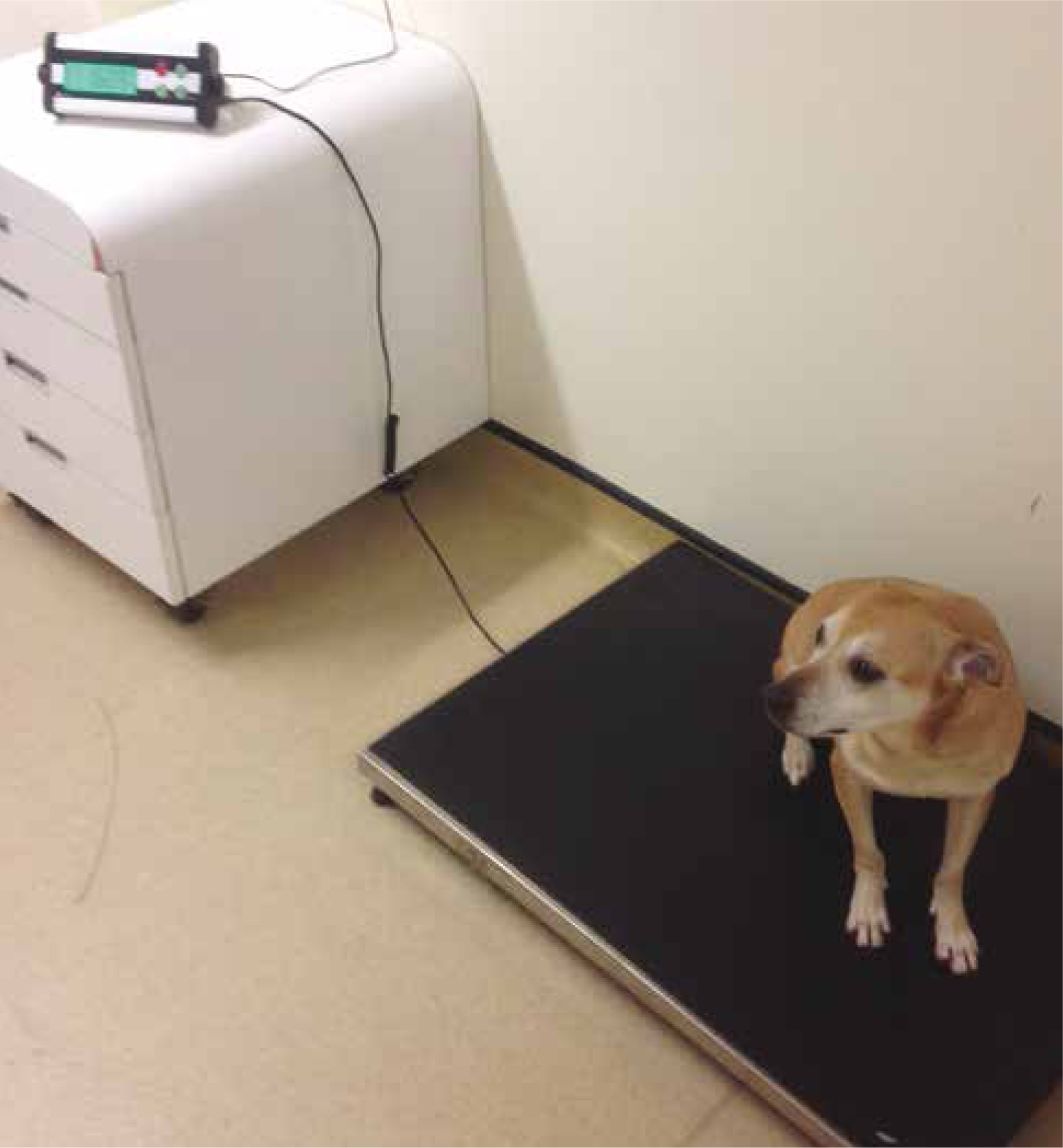
Physical rehabilitation
Physical rehabilitation is the treatment of diseases and injuries with physical agents such as heat, cold, water, sound, electricity, massage and exercise (Tanger, 1984; Monk et al, 2006). Reported health benefits may result from increasing blood and lymph flow through the affected area, resolving inflammation, preventing or minimising muscle atrophy and preventing periarticular contraction, while providing psychological benefits for both the patient and owner (Tanger, 1984; Monk et al, 2006). In recent years, knowledge and research into the benefits of veterinary physical therapy has grown substantially. With regard to joint care, current rehabilitation techniques in veterinary patients are used to reduce pain, control inflammation, improve strength and balance, increase ROM, prevent muscle spasms, and help to maintain/restore more normal joint function (Taylor et al, 2004; Saunders et al, 2005). There are numerous modalities available to help with joint problems in canine patients including cryotherapy, moist heat therapy, therapeutic ultrasound, electrical stimulation and laser therapy. It is beyond the scope of this article to discuss these modalities in detail; the focus, therefore, will be on modalities that may be undertaken within veterinary practice without the need for specialised equipment, and on techniques that owners may be encouraged to continue within the home environment.
In respect of the veterinary nurse's role in physical rehabilitation, there is much that can be undertaken by staff who are confident and competent in the use and application of basic physiotherapy techniques. For example, nursing care plans covering joint disease and the postoperative period should routinely incorporate the basic physiotherapy techniques of massage and passive movements (Lindley and Watson, 2010). It remains the responsibility of the veterinary surgeon to be sure that the nurse is capable of carrying out appropriate physiotherapy procedures, but the nurse must also be sure of working within their own sphere of competence.
Manual therapy
Massage is the purposeful manipulation of the soft tissues of the body and has been used throughout history as part of the art of medicine (Downing, 2011). Massage as a form of therapeutic touch is directed toward a specific purpose targeting physiological change and providing psychological benefit (Sutton, 2004). Massage typically combines several different movements of the hands that have various effects on the tissues. There are many types of massage. Two commonly performed techniques used in veterinary practice are effleurage and petrissage.
Effleurage can be defined as a massage technique where gentle pressure is applied to the skin while moving the hands distal to proximal in the direction of the heart and towards the nearest lymph node (Cartlidge, 2014). Such directional pressure applied during effleurage encourages venous and lymphatic drainage and thus reduces oedema (Johnston et al, 2008). Physical movement of tissues during effleurage helps to break down adhesions that may have formed between tissues which could be contributing to reduced movement and pain (Cartlidge, 2014). Petrissage is performed by lifting and kneading the soft tissues and rhythmically squeezing the deeper muscles. Intermittently, small circles should be made with the heel of the hands at a moderate rate with increasing pressure (Johnston et al, 2008). A massage session may last between 10 to 20 minutes and generally begins with gentle stroking to accustom the patient to touch (Figure 2) and then progresses to effleurage and petrissage. Effleurage is then generally repeated to conclude the session to aid in blood and lymph flow from the treated area (Johnston et al, 2008).
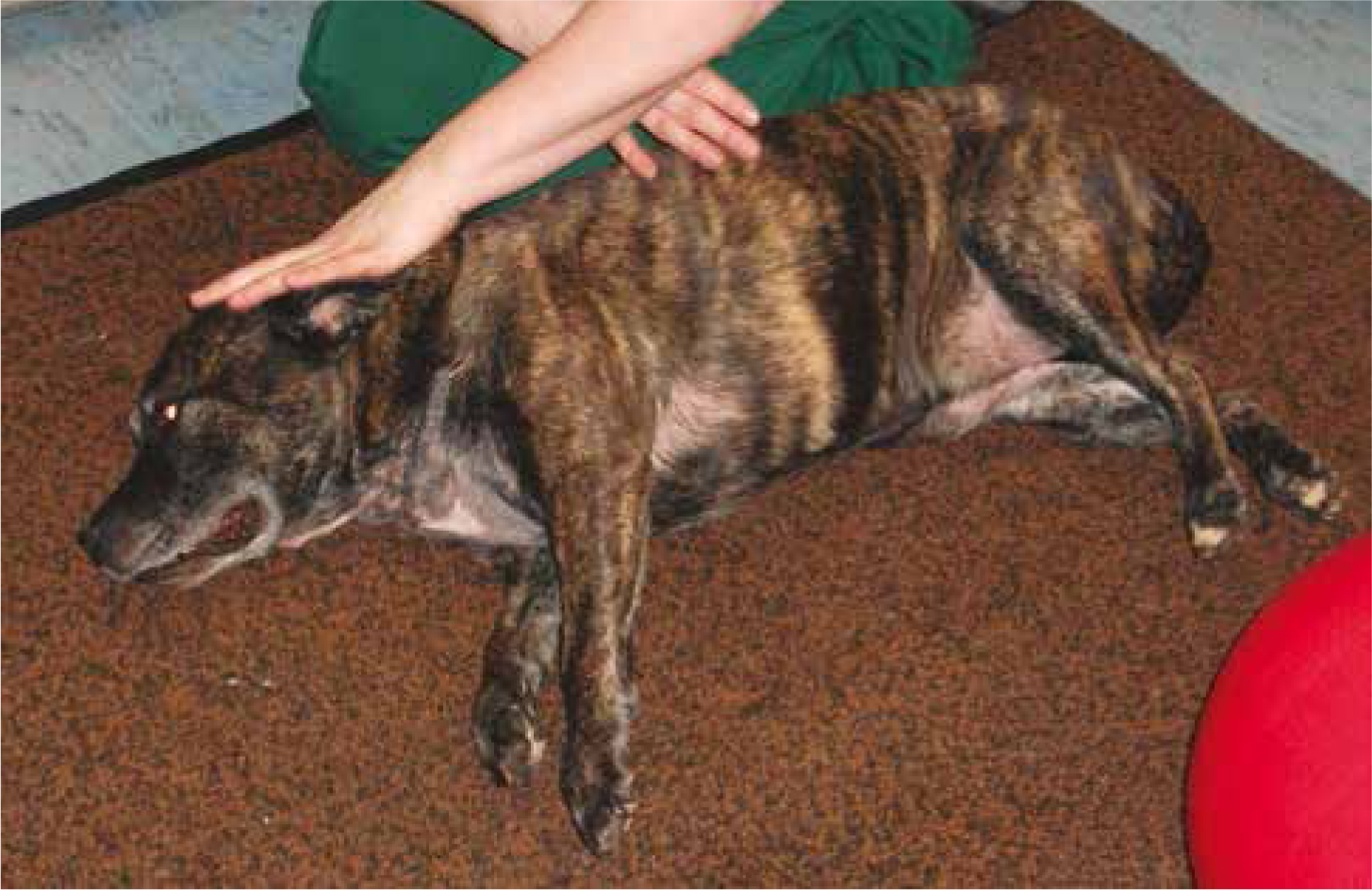
The use of massage prior to the application of other techniques, such as passive range of motion (PROM) exercises, is beneficial as it has been demonstrated to warm the tissues thus making them more flexible (Downing, 2011).
PROM exercise
The objective of PROM exercises is to advance the joint through a comfortable range of motion (ROM). Taking joints through their normal ROM helps to maintain joint health (Olby et al, 2005), increase flexibility, prevent adhesions between soft tissue and bone, and enhance tissue extensibility. The primary objective must always be to advance the joint through a comfortable ROM; at no time should the patient experience discomfort from strenuous manipulation of the limb. Careful patient assessment is required here as not all cases may be suitable for such a technique. Patients suffering from septic arthritis or joint injuries may experience severe discomfort which may limit or prevent this type of therapy.
During PROM therapy, the veterinary nurse moves the joints without effort on the part of the patient. Ideally, each joint of the appendicular skeleton should be moved through flexion and extension slowly and gently, 10–20 repetitions per session, two to three times per day (Johnston et al, 2008; Downing, 2011). This should include the digits of the feet (Figure 3). The joint is grasped on either side and gently manipulated until the desired flexion or extension angle is reached (Figures 4–7). After treatment of the individual joints, the entire limb is moved through a ROM similar to that of ambulation for a minimum of 10 times (Johnston et al, 2008).
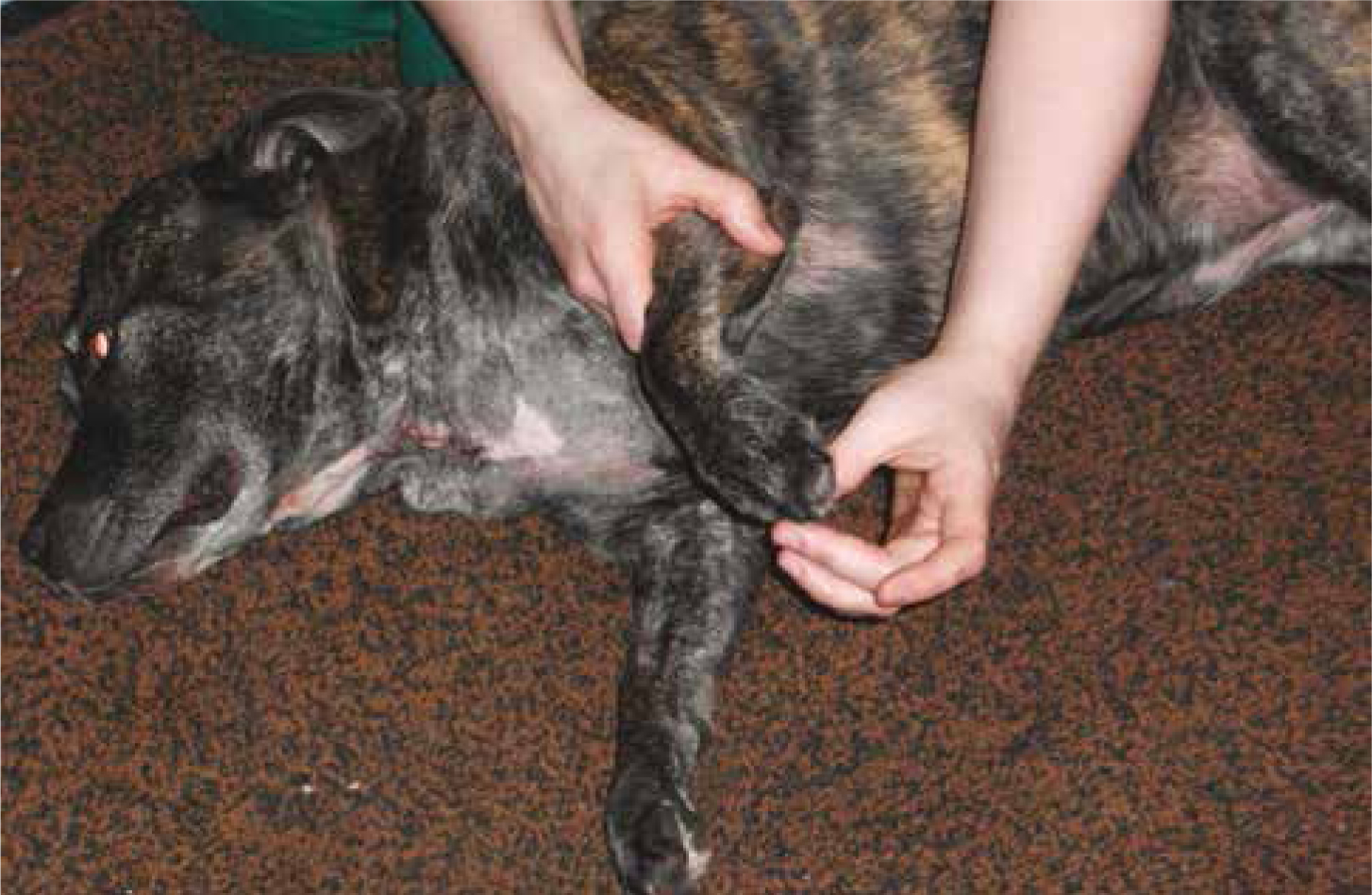
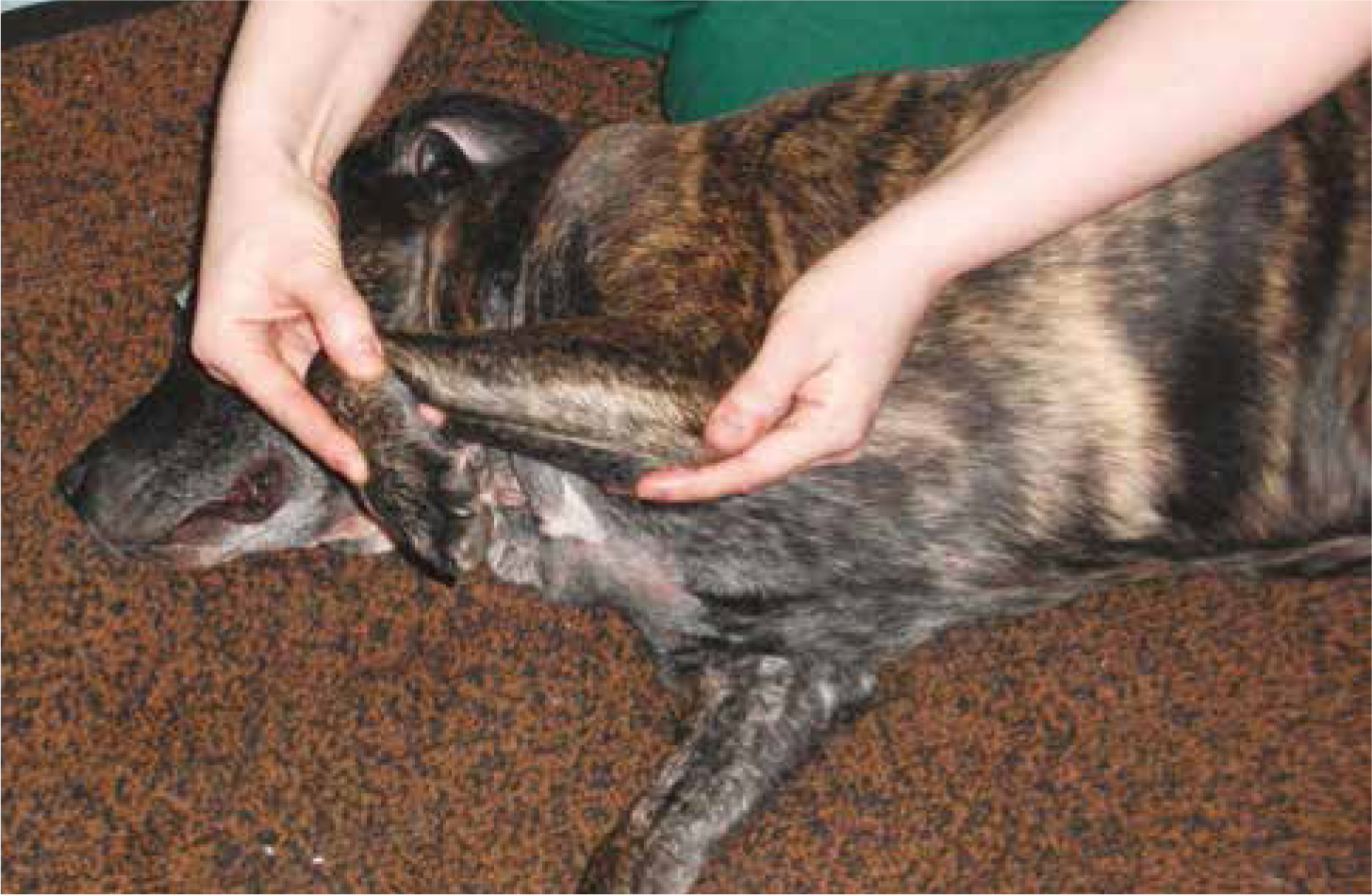
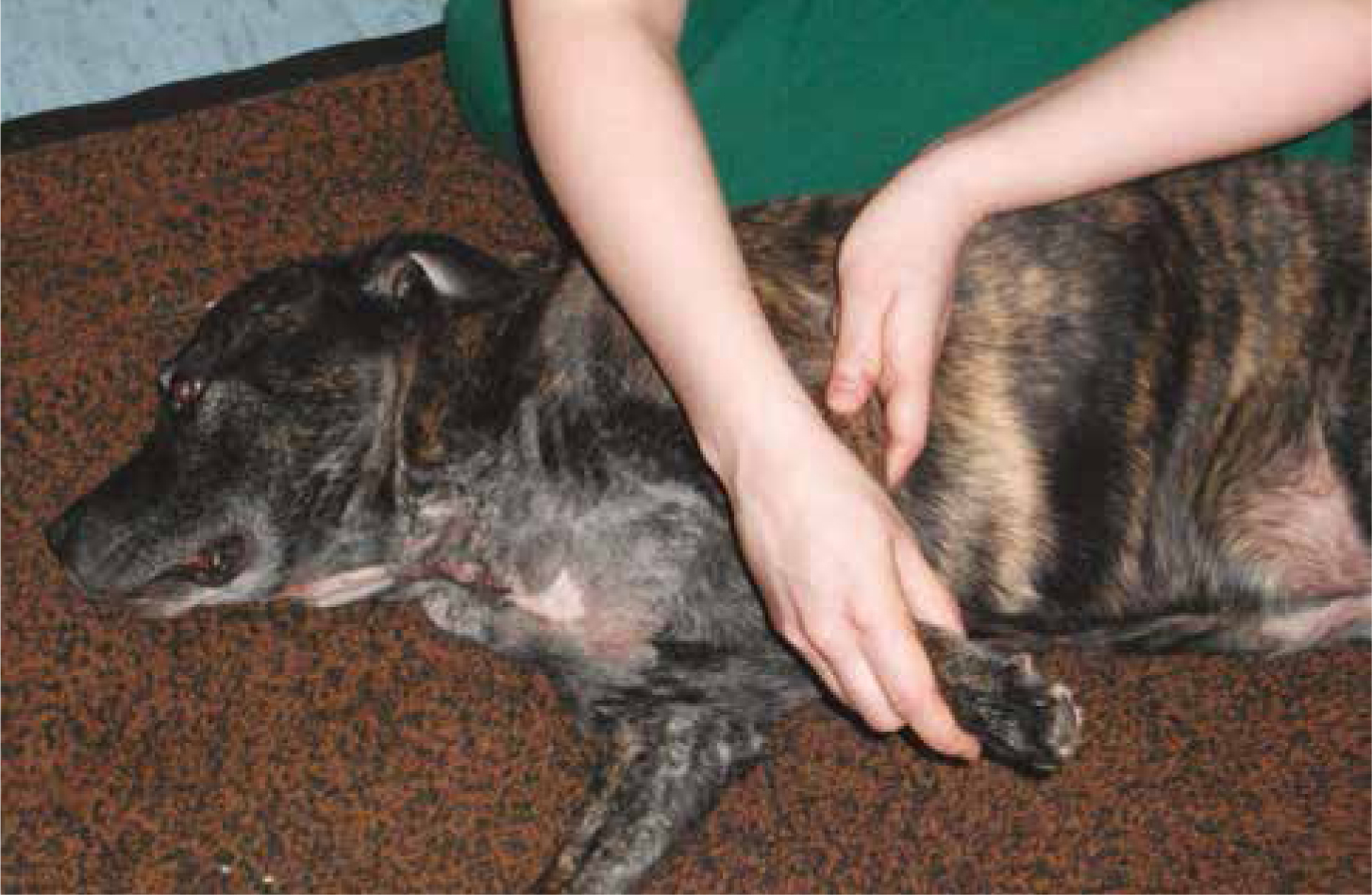
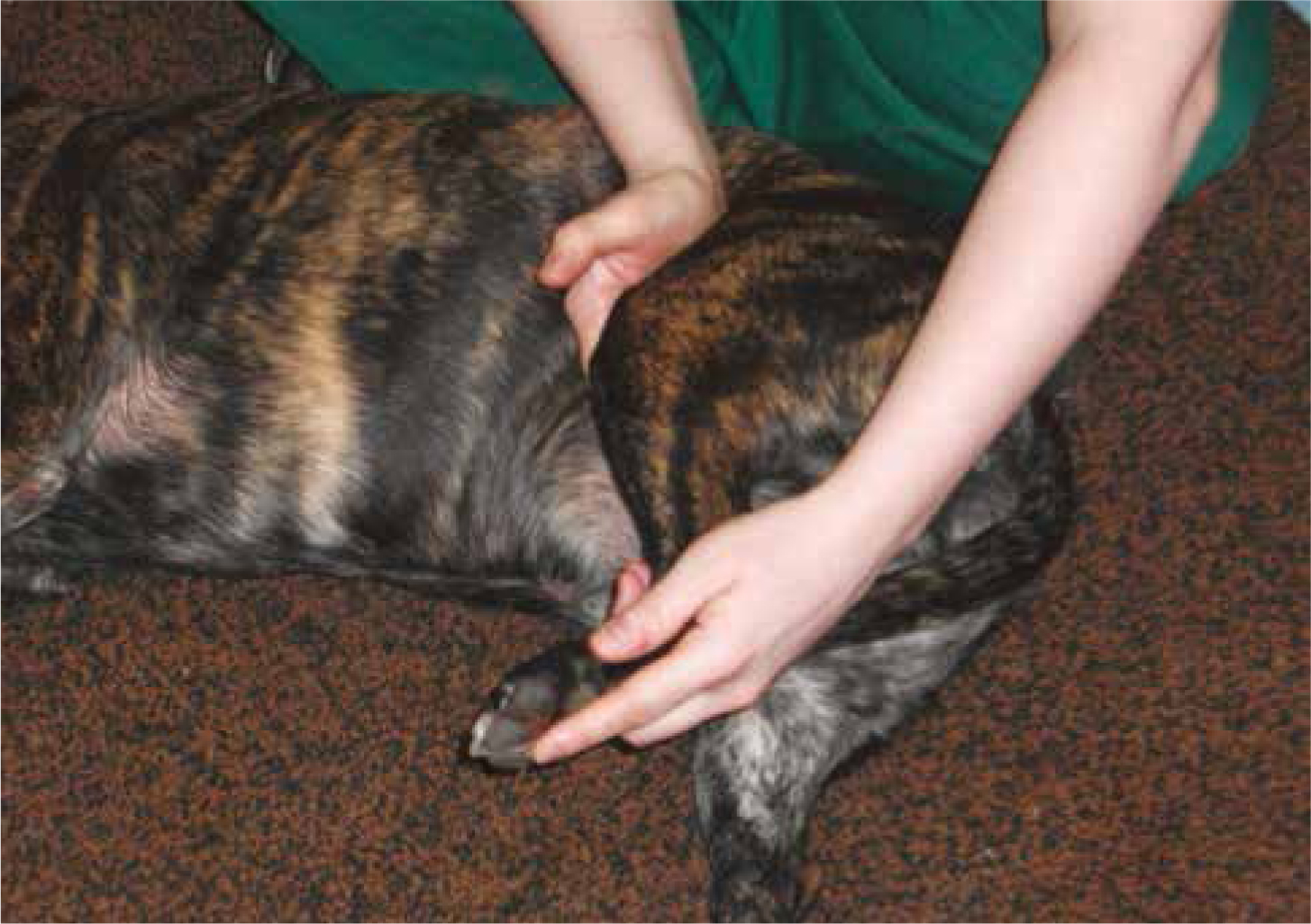
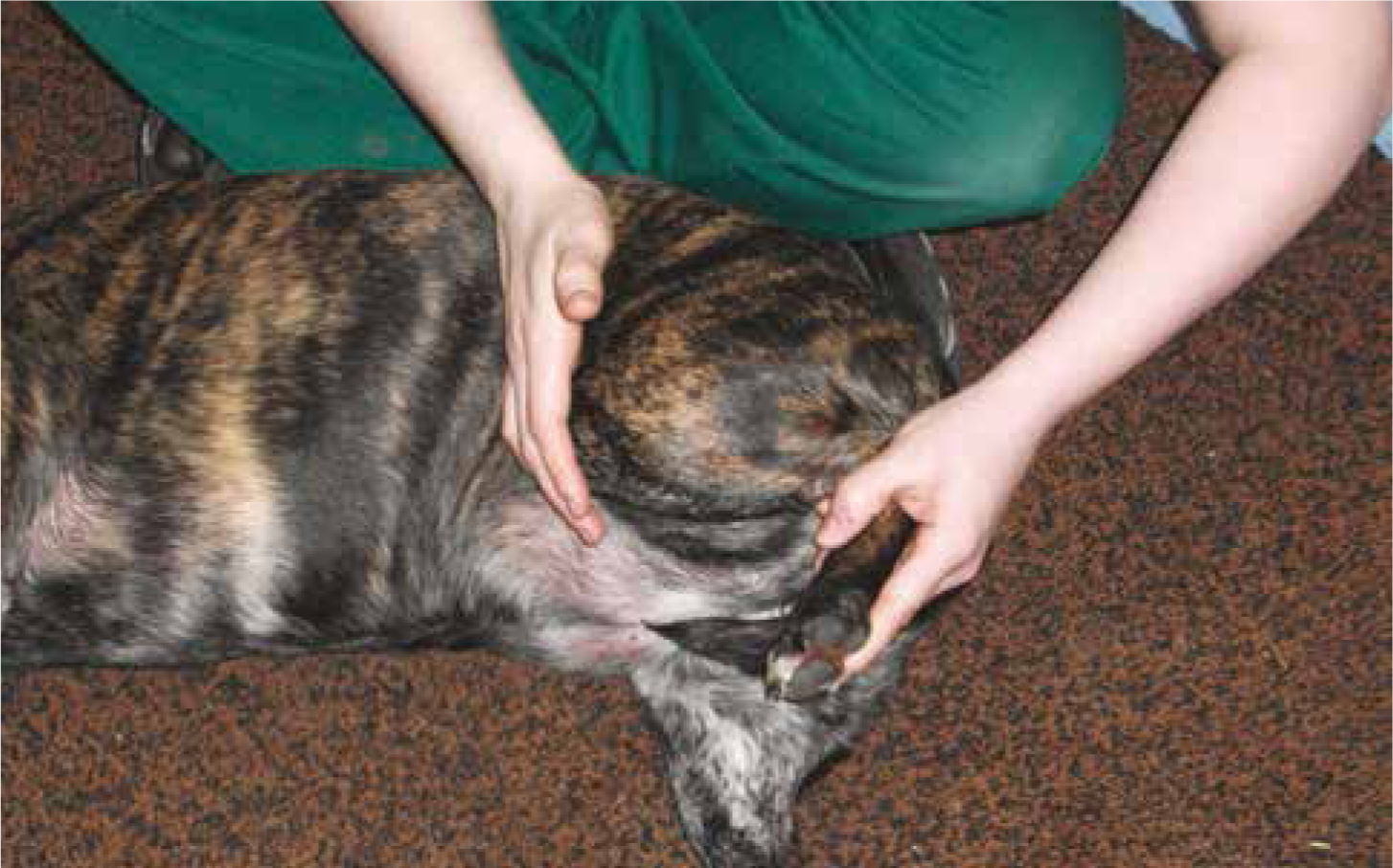
Home exercise programme
Home exercise programmes should be of low intensity and short duration. Cottriall (2014) advocated the use of basic exercises including sitting, lying, leg lifts and balance challenge, suggesting that while these exercises were simple, it was the quality of the position and the holding of the position that was key. Such positions can be demonstrated by the veterinary nurse and taught to the owner to facilitate daily at home. Such exercises need not involve much additional work for busy owners as many can be incorporated into the animal's daily activities. For example, asking the pet to sit and hold the position briefly prior to feeding (Figure 8) and lifting the legs and maintaining the position while drying paws off after a walk. The exercises are generally better received if they are goal-orientated; this should take the form of praise or time with a favourite toy wherever possible. If treats must be used, care must be taken not to undo all the good work achieved via the exercise, hence healthy treats should be selected.
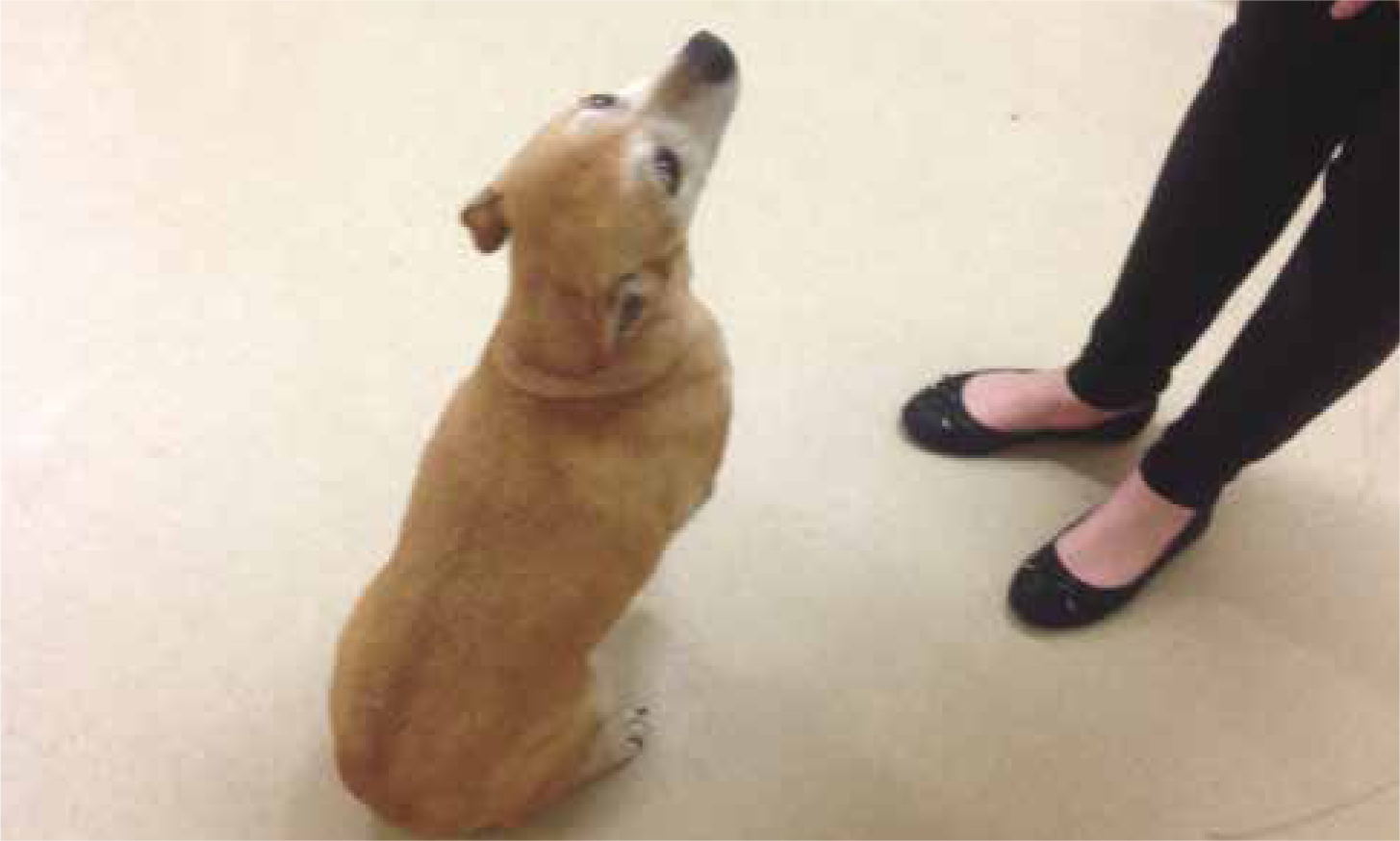
Owners should be informed that overuse of the joints in ageing canines, and particularly those with OA, will likely accelerate the condition and worsen the clinical signs. Moderate exercise, however, should be encouraged to help keep the joints flexible and maintain muscle tone. Veterinary nurses can work with owners to educate them about the importance of a consistent exercise regimen; simply telling owners to avoid ‘excessive’ exercise is subjective and many stoic breeds such as Labradors may hide any signs of pain at the prospect of going for a walk, meaning signs of discomfort may go unnoticed by the owner.
Hydrotherapy
Hydrotherapy is an increasingly popular modality with many veterinary practices now owning an underwater treadmill and/or pool or referring patients for this service elsewhere. Hydrotherapy can be hugely beneficial in ageing canines as it will reduce concussive forces on joints, and help sustain balance, mobility and strength. Underwater treadmills are a popular choice as these ensure steady-paced walking is achieved against resistance; the higher the water, the less the influence of gravity, allowing the animal to pattern its legs through walking without having to work as hard as it would on dry land (Figure 9). In addition to joint and muscle improvements, hydrotherapy is also beneficial for improving and sustaining cardiovascular health (Downing, 2011).
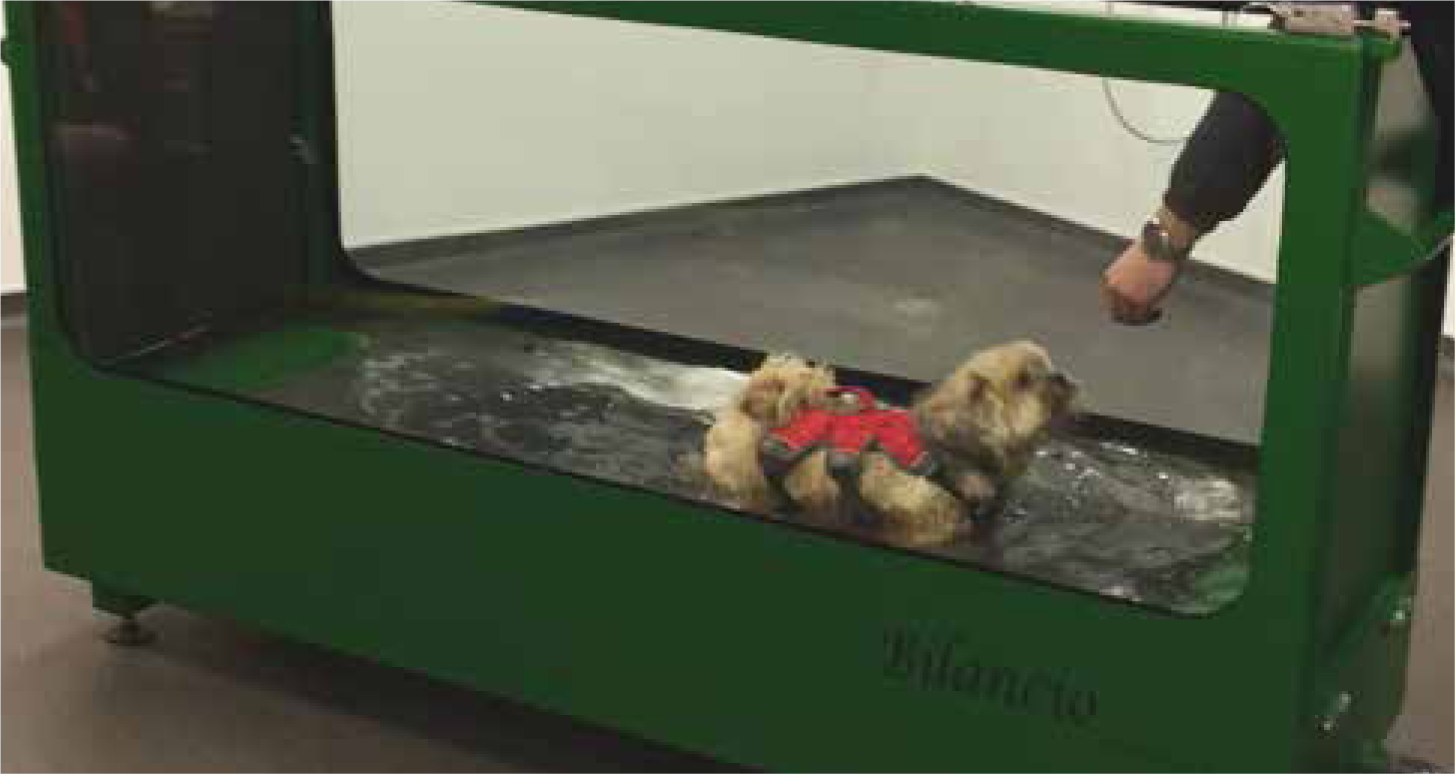
Nutritional supplements
Degenerative joint conditions and especially OA involve an inflammatory component which it may be possible to modify by nutritional supplements. It is beyond the scope of this article to discuss all potential products, however the use of omega 3 fatty acids, glucosamine and chondroitin sulphate and commercial veterinary diets will be briefly outlined.
Omega 3 fatty acids
A number of published human studies demonstrate a beneficial response to n3 fatty acid incorporation into diets of people with rheumatoid arthritis (Simopoulos, 1999; Stamp et al, 2005) This growing body of data shows positive effects of n3 fatty acids on cartilage and its metabolism in the face of degradative enzymes (Budsberg and Bartges, 2006). Curtis et al (2004) provided direct evidence that n3 fatty acid supplementation can reduce or abrogate the inflammatory and matrix degradative response elicited by chondrocytes during OA progression. With regard to published veterinary studies, Roush et al (2010) concluded in their study of 127 dogs that those fed on a diet high in omega 3 fatty acids had a significantly lower serum concentration of arachidonic acid at 6, 12, and 24 weeks. Such findings indicated joint inflammation was reduced when this supplement was fed. Discussion with the owners of the dogs in the trial supported the data, with owners of those fed on the omega rich diet noting an improved ability to rise from a resting position and a noticeable improvement in the quality of their dogs' walking. The use of omega 3 fatty acids has also been proven to assist with a number of other conditions which may affect ageing canines such as cardiovascular disease, cognitive function, neoplasia, renal insufficiency and dermatitis (Harvey, 2011).
Glucosamine (GS) and chondroitin sulphate (CS)
Despite numerous studies on GS and CS in a number of species, data are still scarce regarding exactly how these nutrients affect cartilage metabolism within the joint.
GS is a glycosaminoglycan, which is a component of the extracellular matrix of joint cartilage. Healthy chondrocytes are able to synthesize GS, however this ability is lost in dogs affected by OA (Anderson, 1999). CS is an endogenously produced polysaccharide found in the joint cartilage matrix, which Laflamme (2012) suggested works synergistically with GS to reduce inflammation and slow cartilage deterioration in OA. Anecdotally, there is evidence to support an improvement and slowing down of age-related joint space narrowing along with increased range of mobility and pain reduction in dogs receiving oral GS and CS, however limited scientific study has been undertaken in the veterinary field to date. Sanderson et al (2009) undertook a systematic review of OA and concluded there was moderate evidence for the effectiveness of nutraceuticals in treating the disease, but stated that further high quality studies were required to support this. This is in congruence with Skeldon (2014) who reported that a great number of owners reported such supplements had made a positive difference to their dog's condition, however as yet there is little peer-reviewed published literature to support their use.
There is however published evidence to suggest that the use of GS and CS in human arthritic patients has slowed down joint space narrowing in the patella and significantly improved the clinical signs of OA (Jerosch, 2011). It is important to note however that all positive results for the use of GS and CS were obtained with particular preparations containing these substances and the positive effects should not be extrapolated to over-the-counter human supplements which are readily available from supermarkets and pharmacies, as no guarantee can be given for the content, pharmacokinetics and pharmacodynamics of such products (Henrotin et al, 2005). A number of veterinary nutraceuticals are available for the management of OA in dogs including Synoquin® (VetPlus Ltd), Seraquin® (Boehringer Ingelheim) and YuMove® (Lintbells), and their use is advocated for veterinary patients.
Commercial veterinary diets
Commercial veterinary diets containing nutraceuticals are also available for dogs with OA. A common component of such diets is greenlipped mussel (GLM) extract. GLM extract contains glycosaminoglycans, omega 3 fatty acids, amino acids, vitamins and minerals. There is much anecdotal and some published evidence to show the use of GLM extract can decrease some of the clinical signs of OA, most notably joint pain and swelling. Bierer and Bui (2002) stated that these signs may be alleviated in as little as 6 weeks when dogs are fed diets incorporating GLM extract. Their study, however, did not demonstrate any difference in joint crepitus or ROM between supplemented and unsupplemented dogs. As with GS and CS, further research is required into the use and potential further benefits of this compound.
Conclusion
Current research supports the role of physiotherapy and nutritional supplementation in the management of OA. Furthermore, weight management, including the prevention of obesity and weight reduction if necessary, have a positive impact on the incidence and clinical signs of OA in dogs (Budsberg and Bartges, 2006). The veterinary nurse is pivotal in the care and management of ageing patients with OA and is often of great support to concerned owners.

